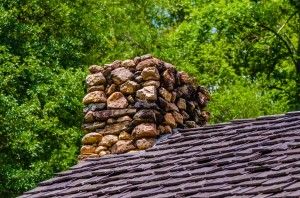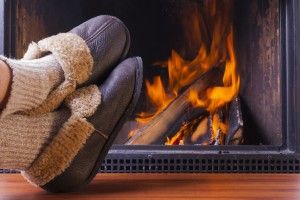In the dead of winter, many Americans use wood burning fireplaces to heat their homes. Staying warm is obviously an essential part of winter survival, but it’s also a wonderful treat to curl up in front of a warm fire, watching as the flames dance, it’s lively shadows filling the room. While the twenty-first century has given us inventions like gas and electric stoves, fireplaces still remain popular fixtures in modern homes. In fact, looking at U.S. Census Bureau data from 1973 – 2013, the popularity of fireplaces in both newly built homes and in sold preexisting homes is on the rise. The Environmental Protection Agency (EPA) estimates there are 29 million fireplaces in use today.

Burning organic materials, like wood, as a heat source is one of the oldest known human activities, with widespread evidence that humans, and perhaps even our evolutionary cousins the Neanderthals, were cooking foods as far back as 700,000 years ago, if not much longer. In fact, Harvard anthropologist Richard Wrangham believes that the use of fire to cook meals made it possible for the human race to spend less energy on digestion, allowing for more energy to put toward evolving a bigger, more capable brain. So in a way, we have the burning of wood and other biomass fuels to thank for part of our evolutionary advantages.
With that being the case, you’d think that our bodies would have evolved to be able to handle smoke and soot, yet modern science tells us otherwise. Most outdoors enthusiasts will be able to tell you how awful it is to accidentally stand too close to the campfire. Smoke inhalation, not burns, is the number one cause of fire-related deaths, causing an estimated 70% of fire fatalities. While some of these deaths occur due to a lack of oxygen, other times the smoke can include chemicals that interfere with our bodies on a cellular level. Smoke particulate and other chemicals can be inhaled into the lungs, and if the particles are small enough, they end up depositing themselves deep into our pulmonary passageways and eventually, our blood cells.
It isn’t just house fires which can be dangerous. When a controlled fire burns, it doesn’t completely burn all of the materials in the fireplace. This is why you see ash left in the fire pit after the flames have been extinguished. Aside from ash, burning firewood can release toxic components into the air like formaldehyde, carbon monoxide, volatile organic compounds (VOCs), nitrogen dioxide, and polyaromatic hydrocarbons (PAHs), benzene, and methane – all of which can cause serious health problems after high amounts of exposure.
It isn’t just fireplaces which are cause for caution; smoke from cooking also causes indoor pollution which has been linked to an astounding 4.3 million deaths annually. Problems can occur from fine/ultra-fine particles like carbon monoxide and PAHs. This includes contaminants that are released from your chimney and actually have the ability to reenter homes nearby through their ventilation systems. If a heating unit was improperly installed, has negative indoor air pressure or downdrafts, it may increase the likelihood of outdoor pollutants making their way inside.

So what can you do to reduce the risks associated with heating your home? Below are some solutions and proactive approaches to reducing indoor air contaminants related to indoor heating units, provided by the EPA and the Hearth, Patio and Barbeque Association.
- If using a woodstove or fireplace, have it inspected and cleaned by a trained professional at the beginning of every heating season, to ensure it’s clear of obstructions and buildup. Along with soot and ash, fires releases creosote into the air. If this residue builds up inside the chimney, even as little as 1/8 to 1/4 of an inch, it can ignite. To avoid explosions within a fireplace, creosote buildups must be cleaned out of the chimney on a regular basis.
- If a wood stove was purchased before 1988, it was manufactured before the EPA started requiring wood stove producers to comply with strict standards for reducing and eliminating particulate emissions. Remove and replace old wood stoves, and replace them with newer, cleaner-burning stoves. The EPA even has information on funding the replacement of your current wood stove.
- While operating, ensure wood stove doors are fit tightly and any leaks are promptly repaired.
- Watch out for wood that has a high moisture content. Wood that is not properly dried, or seasoned, will burn less efficiently and release more harmful pollutants. Wood moisture meters are available for purchase at woodworking specialty shops or online for under $25.
- Never burn plastics, charcoal, garbage, or newspapers, and don’t use any gasoline or liquid accelerant to help start fires. Use only aged or cured (dried) wood.
- Ensure there aren’t any backdrafts, which are places where air that should be leaving your home is actually being brought back (along with contaminants) into your home.
- Ensure you have smoke and carbon monoxide detectors, and they are working. The recommendation is to change detector batteries every 6 months. Also keep a fire extinguisher handy.
- As always – keep small children and pets away from heat sources. Use a grate or fire screen for a barrier, and never leave a fire unattended!
The EPA recently finalized new emissions rules for residential wood heaters. In addition to the information already shared in this article, the EPA’s Burn Wise website offers a comprehensive list of tools and resources for the reduction of wood smoke. With the prevalence of fireplaces and wood stoves, it is very important to practice safe burning within your home.
Regardless of how you heat your home, it is important to give careful consideration to your air quality. Distinct and immediate atmospheric dangers can also come from the exposure to particles, chemicals and gasses released since no fuel can be consumed completely. Numerous studies have found illnesses were directly related to particle pollution including, but not limited to, irritation of the airways, high blood pressure, impaired insulin sensitivity, decreased lung function, aggravated asthma or COPD, development of chronic bronchitis, irregular heartbeat, nonfatal heart attacks, premature death in people with heart or lung disease. If you’re concerned about potential problems from indoor pollutants, consider a medical grade air purifier with HEPA and activated carbon to help to remove those pesky airborne particulates while you enjoy that toasty fire.
